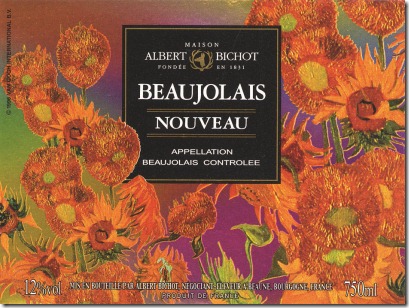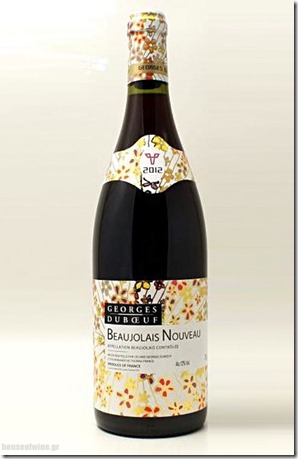For half a century the practical and business like Beaujolaisians have been dashing into their vineyards in September (regardless of how hot or not the summer has been), picking every Gamay grape in sight, rushing them to the crushers and fermenters in their wineries, tweaking the bubbling brew and when (just about) fermented bottling the stuff and getting it to imbibers the world over by the third Thursday in November.
Good wine? Well….… Good business? Most certainly. How many winemakers gather the grapes in September and have the money for the wine in their hot little hands in November?
The whole thing started almost accidentally. The Beaujolais has always been something on its own, because its red grape, the Gamay, doesn’t really thrive anywhere else. The wines have a special, fruity, zesty characteristic and some of the village Crus can not only be wonderful, but good for some years. But young Beaujolais, too has always been a joy, but in recent years, the annual hype of Beaujolais Nouveau has rather clouded the image.
Tradition has it, and I am old enough to believe that this is true, that village winemakers used to sample the new wines among themselves a couple of months after the harvest in local tavernas and cafés, where some ‘outsiders’ from neighbouring towns got to try it. They liked it, and bought it. Soon there was a lively trade in the year’s “New Wine”.
It was not long, of course, before smart Negociants got into the act and soon the new wine was going by truck and train to Paris and other French cities, with attendant promotion. In those early years the wine was good; earthy, fruity, spritzy. I remember in the early 1970s sitting outside a Parisian bistro on a cold December day (it was full inside) with a bowl of steaming, oven-baked-cheese-topped thick onion soup, a Baguette and a bottle of Nouveau in front of me. Lovely! The wine went well with the soup as it did with the Bifstec/Frites which followed.
Then the smart marketing boys got into the act and in no time at all restaurants, hotels and wine importers the world across were vying with each other to be the first to get the Beaujolais on their tables soonest. So, demand became enormous and the Beaujolaisians responded in the way people on to a good thing do – increasing production and increasing the prices. The Nouveau became disappointing and overpriced and I remember writing in my weekly newspaper wine column in 1995 about the low calibre of that year’s wine.
In the past few years, it could be that some at least of the Beaujolaisians have got their act together and the wine has improved a bit and prices have become more reasonable. I have to admit that I have not gone to any of the parties or special events and that for some years now have only bought a bottle or two just to see how its getting on. This year, prices around six quid. If I do try it, it will almost certainly come from just down the road and it will be Georges Duboeuf’s, from Waitrose.
Patrick Skinner
The Case of Beaujolais Nouveau
by Matthew Stowell
This year, Thursday 15th. November, is the official release date of Beaujolais Nouveau, which in the past was celebrated by a great many people in the wine business but lately has fallen into disfavour. Beaujolais Nouveau is considered by connoisseurs to be an inferior wine that became popular only through a publicity gimmick and as a way for wine merchants and negociants to reap much needed cash before they could earn a penny from their serious wines. Wine writer Karen MacNeil says drinking Nouveau is like eating cookie dough. Another critic calls it “wine bubblegum”.
If that sounds harsh, consider the fact that since at least 2001, Beaujolais Nouveau makers have had to dump millions of gallons of unsold, undrinkable wine down the drain because it was past its expiration date (about six months after release). The Beaujolais region, through so much hype and a bit of scandal, basically shot itself in the foot over Nouveau.
Still, this doesn’t mean that all Beaujolais Nouveau is plonk. Georges Duboeuf, who started the whole frenzy back in the late 60s, still makes enjoyable Nouveau and there are two or three others (Albert Bichot and Domaine des Crêtes among them) that produce a higher grade quaff that raises the level—again, as long as it’s drunk before May and as long as you don’t expect the degree of substance or depth you will find in other Beaujolais reds such as Morgon, Moulin-a-Vent or Julienas.
Why does Nouveau have such a short shelf life? Because it is made quickly and because it uses carbonic maceration (or whole berry fermentation), which preserves the fresh fruity qualities of the Gamay grape but neglects to extract the tannins from the skins. Then it is pasteurized to prevent further fermentation. One positive outcome from this method is that there is usually greater noticeable variation from year to year in the taste of the fruit. The 2000 vintage was so exceptional that the wine was still enjoyable by the following November. And this year’s harvest is supposed to be one of the best in recent years.
Until World War II, Nouveau was restricted to local village consumption as a way to foretell how the later good stuff was going to taste and to relieve the long months of thirst between bottlings. In the late 60s, Duboeuf and a few others put together a well- publicized race that transported barrels of Nouveau from the vineyards to the cafés and taverns of Paris. This grew in popularity as the Parisian establishments participated and competed to have the honour of being the first to serve Nouveau. In those days, it was officially released every November 15th. Later, Mr Duboeuf lobbied to have the date changed to the third Thursday of November so that he might take advantage of weekend marketing opportunities.
publicized race that transported barrels of Nouveau from the vineyards to the cafés and taverns of Paris. This grew in popularity as the Parisian establishments participated and competed to have the honour of being the first to serve Nouveau. In those days, it was officially released every November 15th. Later, Mr Duboeuf lobbied to have the date changed to the third Thursday of November so that he might take advantage of weekend marketing opportunities.
Since then, other countries have jumped on the bandwagon, producing similar ‘nouveaus’. Italy has its Vino Novello, Spain has Vino Nuevo, the US produces several variations labelled Nouveau Wine—even Serbia has joined in, promoting its Blauer Portugiese on the same third Thursday. At 11 a.m. on 11/11 of every year, the Czech Republic releases its Saint Martin wine, which can be red, white or rosé.
Fun Facts About Beaujolais Nouveau
- It is always released the 3rd Thursday of November, no matter when the harvest began
- All grapes must be hand-picked. Only Champagne has the same restriction
- Gamay (Gamay Noir a Jus Blanc) is the only grape allowed
- California produces a “Gamay Beaujolais” but it is not the same grape
- Nearly half of the Beaujolais region’s crop goes into making Nouveau
- It is an extremely versatile wine that will pair well with almost any food
- The largest importers are Germany, Japan and the USA

